Family: Siricidae
Subfamily: Siricinae
Genus: Sirex Linnaeus, 1760
Species: Sirex nigricornis Fabricius, 1781
Common names: none
Sirex nigricornis is an eastern NearcticNearctic:
describing the region of the Northern Hemisphere that includes North America south through northern Mexico
 species. It is generally metallic black with a partially reddish-brown abdomenabdomen:
species. It is generally metallic black with a partially reddish-brown abdomenabdomen:
the third and last segment of an insect's body; in sawflies this is usually made up of 11 segments (segments 9 and 10 often fused)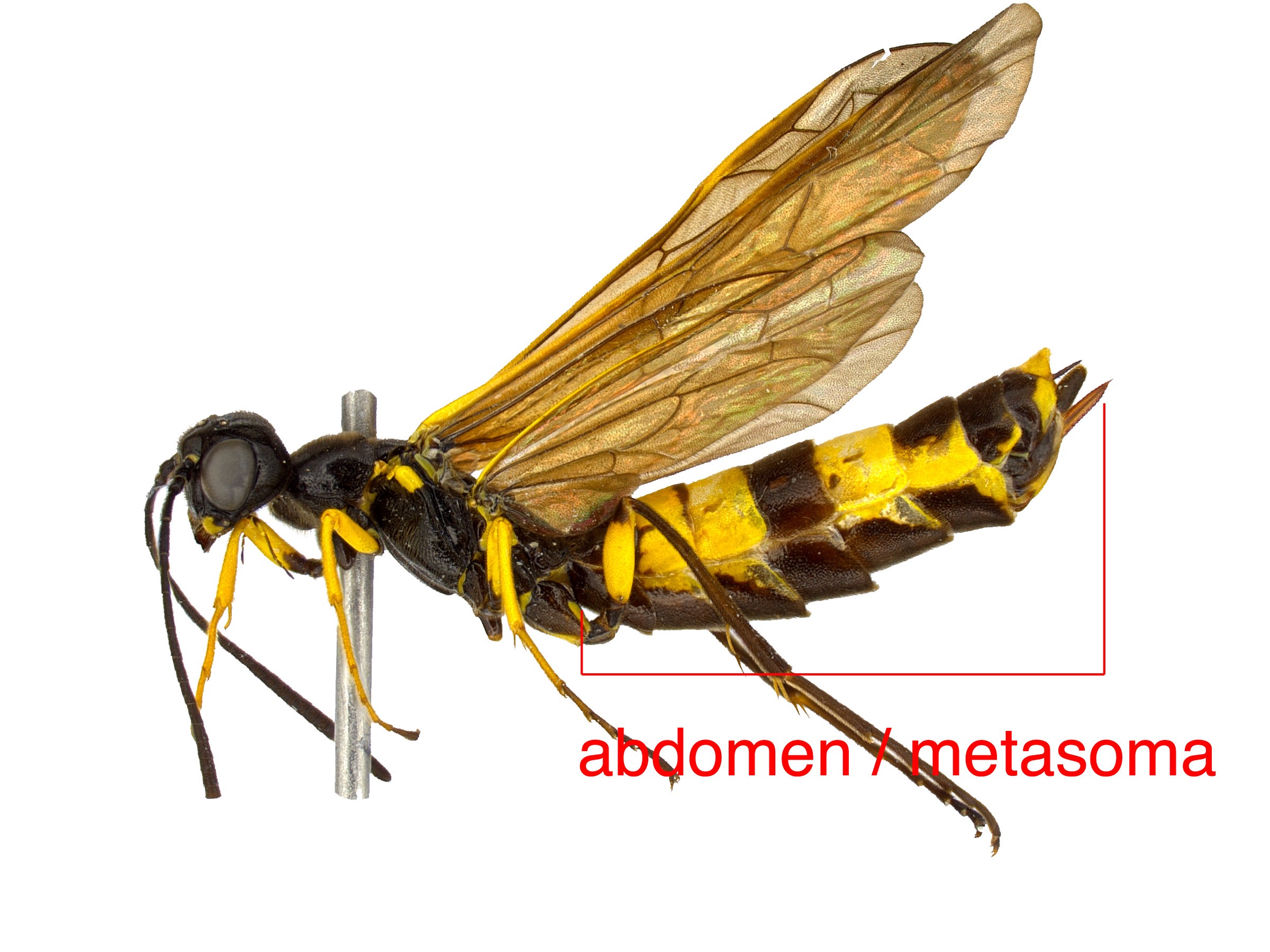 , and sometimes entirely black with uniformly darkened wings (Schiff et al. 2006Schiff et al. 2006:
, and sometimes entirely black with uniformly darkened wings (Schiff et al. 2006Schiff et al. 2006:
Schiff NM, Valley SA, LaBonte JR, and Smith DR. 2006. Guide to the siricid woodwasps of North America. USDA Forest Service Forest Health Technology Enterprise Team FHTET-2006-15. 102 pp.).
This species has two color morphs that used to be classified as two species, S. nigricornis and S. edwardsii. Morphological and genetic analysis have placed these two groups into a single species, and S. edwardsii is now a junior synonym (Schiff et al. 2012Schiff et al. 2012:
Schiff NM, Goulet H, Smith DR, Boudreault C, Wilson AD, and Scheffler BE. 2012. Siricidae (Hymenoptera: Symphyta: Siricoidea) of the Western Hemisphere. Canadian Journal of Arthropod Identification 21: 1-305.).
See Sirex for genus-level diagnostic characteristics.
Females:
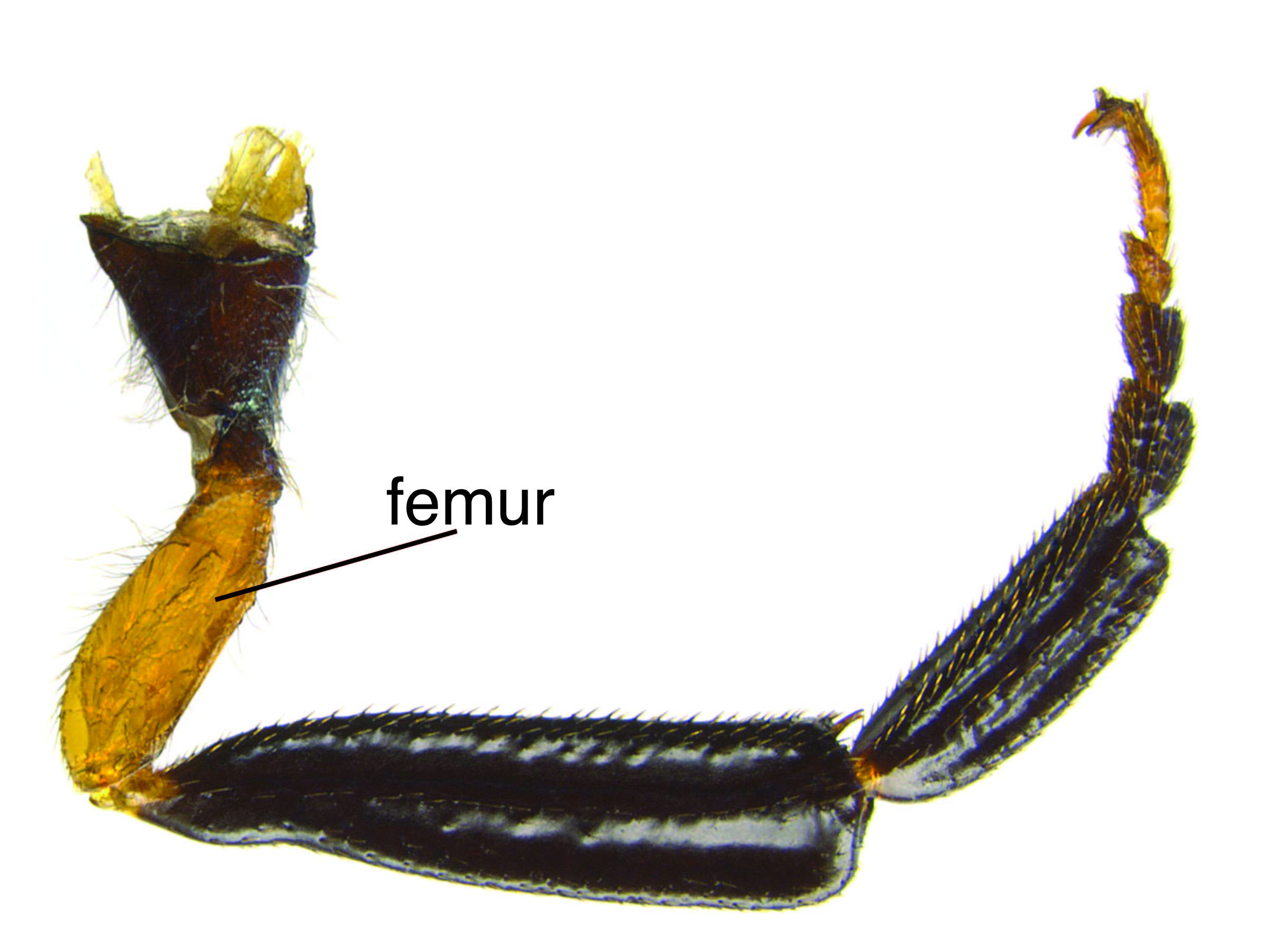 usually light reddish-brown and rarely partially black or entirely black (Schiff et al. 2012Schiff et al. 2012:
usually light reddish-brown and rarely partially black or entirely black (Schiff et al. 2012Schiff et al. 2012: metallic blue-black (Schiff et al. 2012Schiff et al. 2012:
metallic blue-black (Schiff et al. 2012Schiff et al. 2012: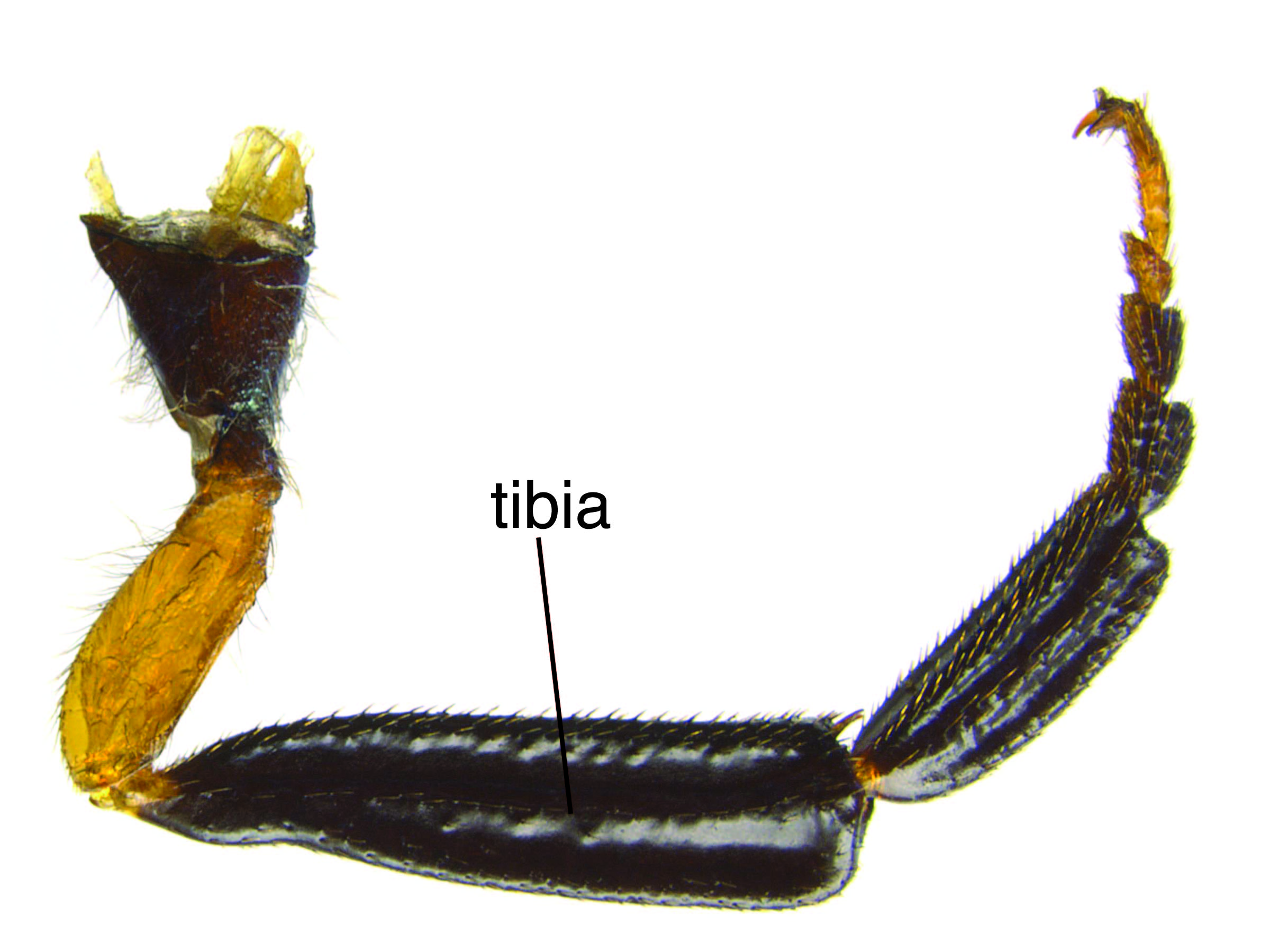 light reddish-brown (Schiff et al. 2012Schiff et al. 2012:
light reddish-brown (Schiff et al. 2012Schiff et al. 2012: small, about 0.1–0.25 times size of laterallateral:
small, about 0.1–0.25 times size of laterallateral: scattered, about 2–10 pit diameters apart (Schiff et al. 2012Schiff et al. 2012:
scattered, about 2–10 pit diameters apart (Schiff et al. 2012Schiff et al. 2012: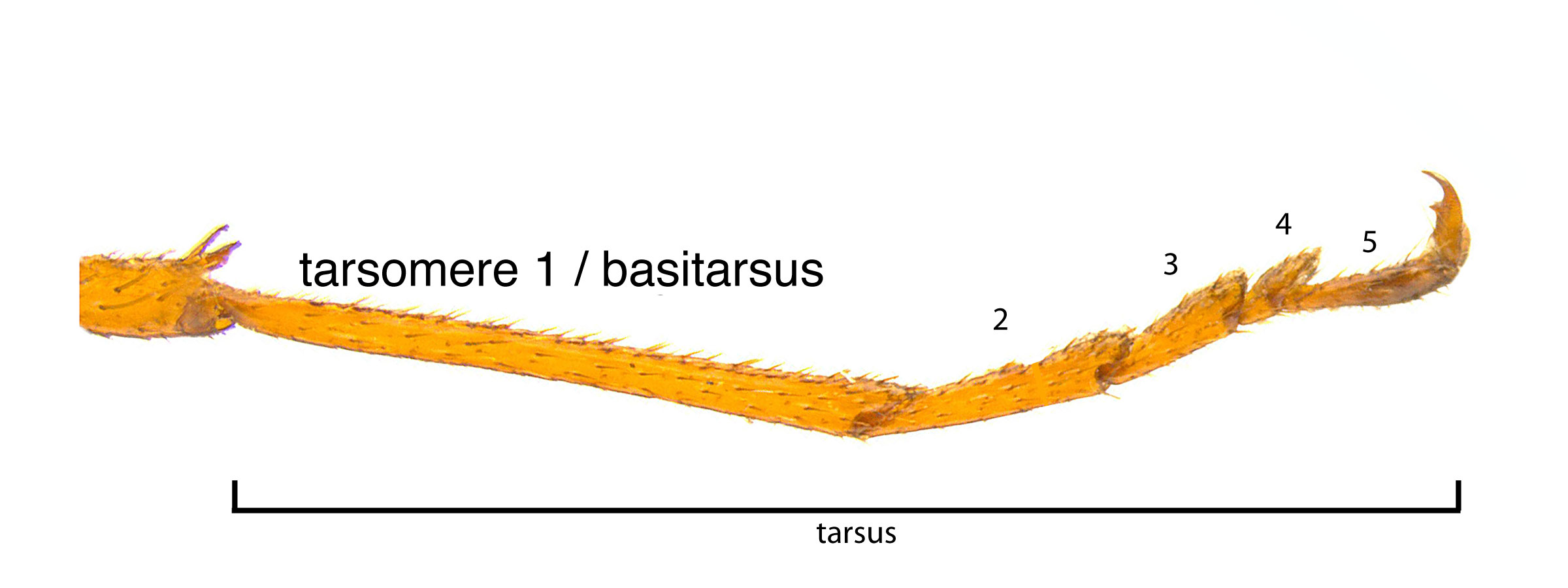 2–3.5 times as long as wide (Schiff et al. 2012Schiff et al. 2012:
2–3.5 times as long as wide (Schiff et al. 2012Schiff et al. 2012: pits with projections, forming a net-like pattern (Schiff et al. 2012Schiff et al. 2012:
pits with projections, forming a net-like pattern (Schiff et al. 2012Schiff et al. 2012: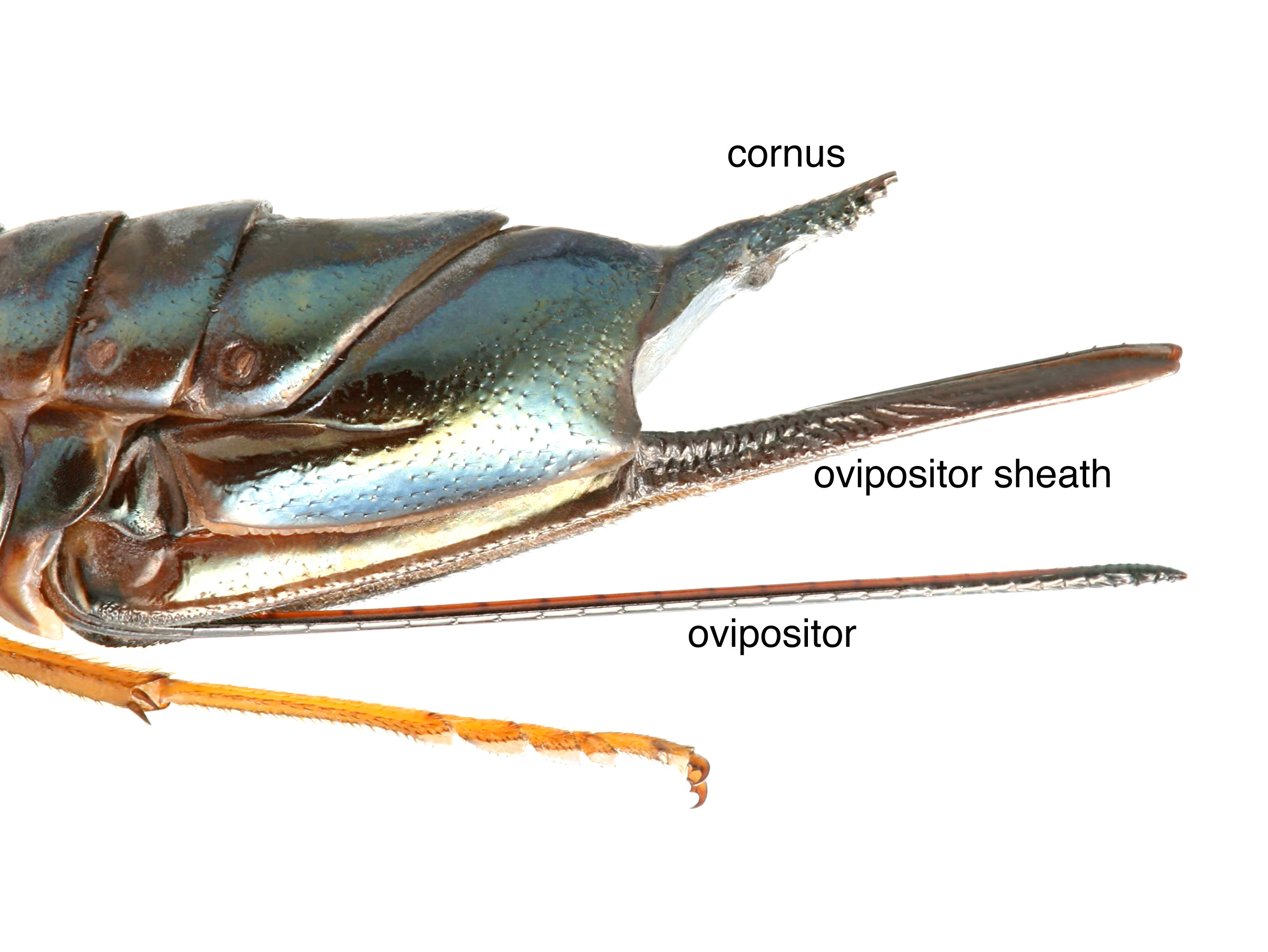 with clear pits, including annulusannulus:
with clear pits, including annulusannulus: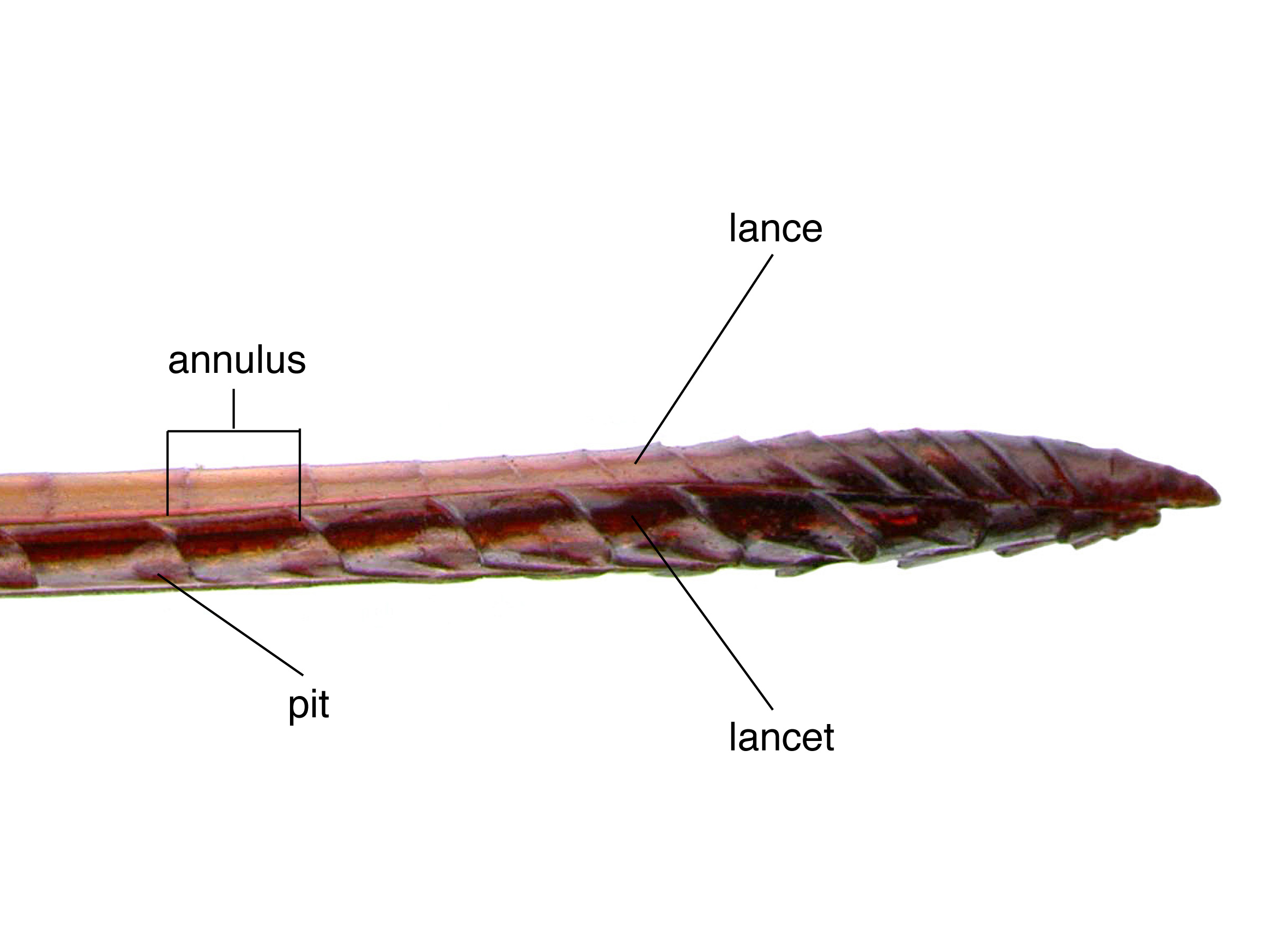 2; some pits smaller than others towards the middle (Schiff et al. 2012Schiff et al. 2012:
2; some pits smaller than others towards the middle (Schiff et al. 2012Schiff et al. 2012: with pulvilluspulvillus:
with pulvilluspulvillus: 0.8 times length of tarsomeretarsomere:
0.8 times length of tarsomeretarsomere: (Schiff et al. 2012Schiff et al. 2012:
(Schiff et al. 2012Schiff et al. 2012: annulusannulus:
annulusannulus: 10 length 1.3–2 times width (Schiff et al. 2012Schiff et al. 2012:
10 length 1.3–2 times width (Schiff et al. 2012Schiff et al. 2012:Males:
 completely black (Schiff et al. 2012Schiff et al. 2012:
completely black (Schiff et al. 2012Schiff et al. 2012: dark blue with metallic reflections (Schiff et al. 2012Schiff et al. 2012:
dark blue with metallic reflections (Schiff et al. 2012Schiff et al. 2012: black; fore and mid tibiaetibia:
black; fore and mid tibiaetibia: and tarsitarsus:
and tarsitarsus: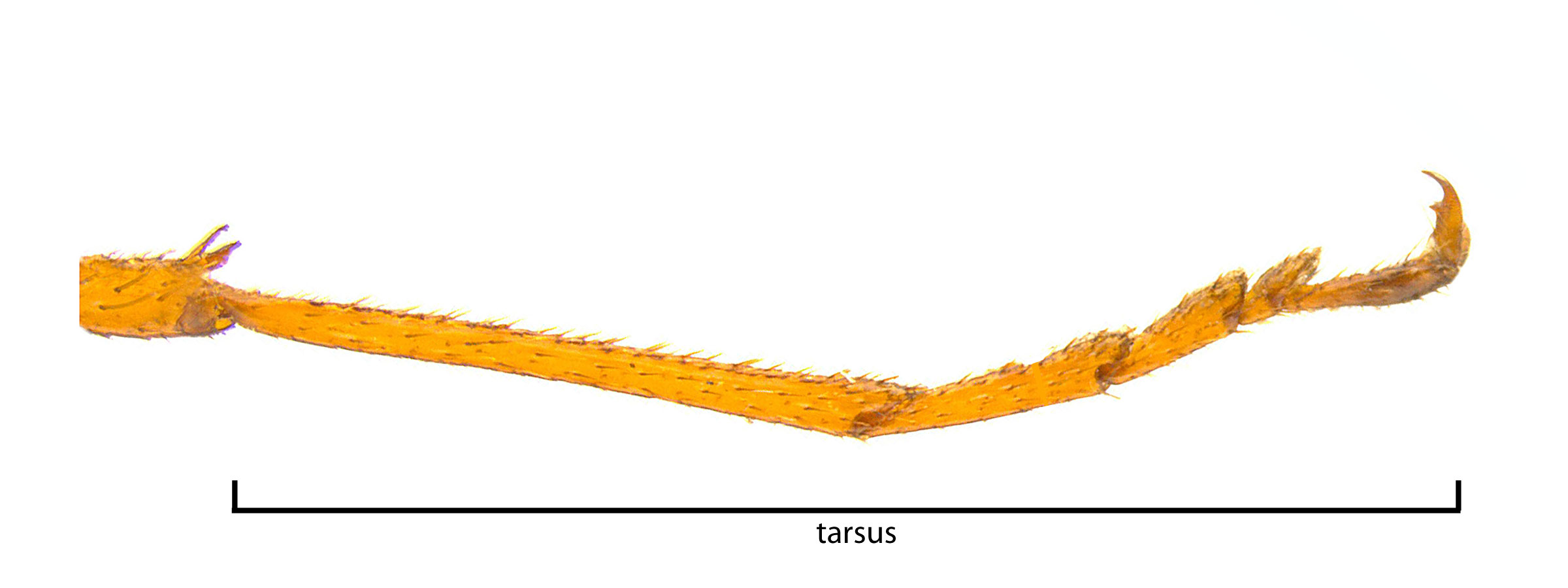 reddish-brown (or sometimes paler) (Schiff et al. 2012Schiff et al. 2012:
reddish-brown (or sometimes paler) (Schiff et al. 2012Schiff et al. 2012: pits with tooth-like projections, margins forming a net-like pattern (Schiff et al. 2012Schiff et al. 2012:
pits with tooth-like projections, margins forming a net-like pattern (Schiff et al. 2012Schiff et al. 2012: pits dense, about 0–1 diameters apart (Schiff et al. 2012Schiff et al. 2012:
pits dense, about 0–1 diameters apart (Schiff et al. 2012Schiff et al. 2012: either black with tergites 5 and 6 reddish-brown, OR abdomenabdomen:
either black with tergites 5 and 6 reddish-brown, OR abdomenabdomen: reddish-brown with tergites 1 or 1–2 black (Schiff et al. 2012Schiff et al. 2012:
reddish-brown with tergites 1 or 1–2 black (Schiff et al. 2012Schiff et al. 2012:Both sexes of Sirex nigricornis can be distinguished from S. behrensii by a lack of fore wingfore wing:
the anterior wing of each pair of wings; usually the largest wing of the pair
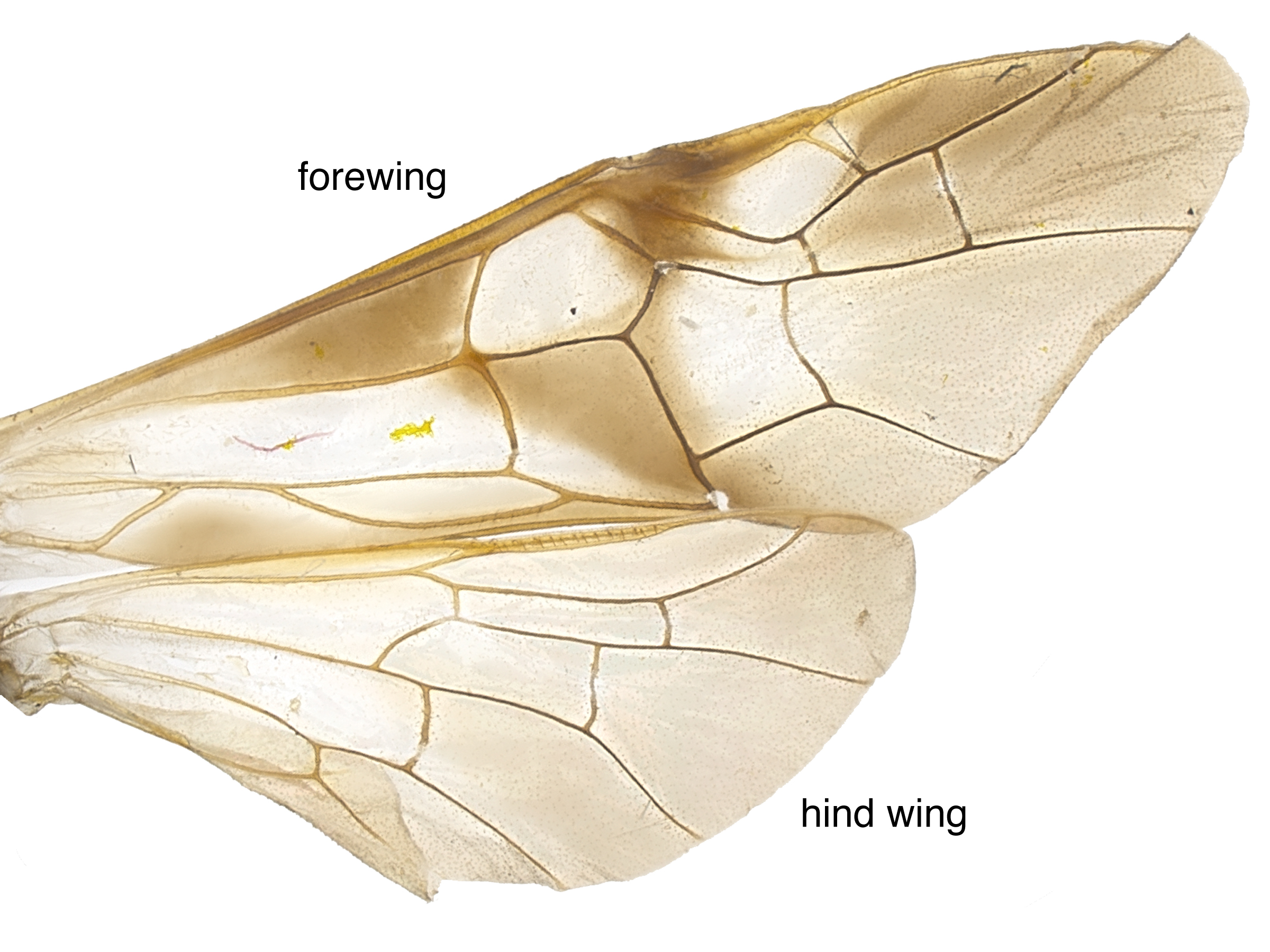 vein 3A, lack of banded pattern on the wing, and hind leghind leg:
vein 3A, lack of banded pattern on the wing, and hind leghind leg:
the third and posterior-most leg
 color patterns (Schiff et al. 2012Schiff et al. 2012:
color patterns (Schiff et al. 2012Schiff et al. 2012:
Schiff NM, Goulet H, Smith DR, Boudreault C, Wilson AD, and Scheffler BE. 2012. Siricidae (Hymenoptera: Symphyta: Siricoidea) of the Western Hemisphere. Canadian Journal of Arthropod Identification 21: 1-305.).
Individuals of S. nigricornis fall into two color patterns. The pale form, with reddish-brown on the legs and abdomenabdomen:
the third and last segment of an insect's body; in sawflies this is usually made up of 11 segments (segments 9 and 10 often fused) , is found in higher proportions in the eastarn portion of its range, while the black form, mostly black throughout the body, is more commonly found in the west (Schiff et al. 2012Schiff et al. 2012:
, is found in higher proportions in the eastarn portion of its range, while the black form, mostly black throughout the body, is more commonly found in the west (Schiff et al. 2012Schiff et al. 2012:
Schiff NM, Goulet H, Smith DR, Boudreault C, Wilson AD, and Scheffler BE. 2012. Siricidae (Hymenoptera: Symphyta: Siricoidea) of the Western Hemisphere. Canadian Journal of Arthropod Identification 21: 1-305.).
Sirex species feed on trees of Pinaceae and Cupressaceae. Sirex nigricornis is recorded on Pinaceae species Pinus banksiana (jack pine), P. clausa (sand pine), P. echinata (shortleaf pine), P. elliotti (slash pine), P. palustris (longleaf pine), P. resinosa (red pine), P rigida (pitch pine), P. strobus (eastern white pine), P. sylvestris (Scots pine), P. taeda (loblolly pine), P. virginiana (Virginia pine), and Picea abies (Norway spruce). The majority of specimens reared (94%) have been on Pinus spp. (pine) (Schiff et al. 2012Schiff et al. 2012:
Schiff NM, Goulet H, Smith DR, Boudreault C, Wilson AD, and Scheffler BE. 2012. Siricidae (Hymenoptera: Symphyta: Siricoidea) of the Western Hemisphere. Canadian Journal of Arthropod Identification 21: 1-305.).
Female Sirex harbor symbiotic basidiomycete fungus in abdominal glands called mycangia. During oviposition, the site is inoculated with the fungus, which begins to decompose the surrounding wood. LarvaeLarva:
the immature stage of holometabolous insects
 feed on the fungus, and in the process bore galleries through the wood (Johnson 1930Johnson 1930:
feed on the fungus, and in the process bore galleries through the wood (Johnson 1930Johnson 1930:
Johnson CW. 1930. On the variation and abundance of Sirex nitidus Harris. Psyche 37 (3): 281-282. https://doi.org/10.1155/1930/62786, Schiff et al. 2012Schiff et al. 2012:
Schiff NM, Goulet H, Smith DR, Boudreault C, Wilson AD, and Scheffler BE. 2012. Siricidae (Hymenoptera: Symphyta: Siricoidea) of the Western Hemisphere. Canadian Journal of Arthropod Identification 21: 1-305.). The mycangia of S. nigricornis individuals harbor either Amylostereum areolatum or A. chailletii fungus (Hajek et al. 2013Hajek et al. 2013:
Hajek AE, Nielsen C, Kepler RM, Long SJ, and Castrillo L. 2013. Fidelity among Sirex woodwasps and their fungal symbionts. Microbial Ecology 65: 753-762. https://doi.org/10.1007/s00248-013-0218-z).
Larvae are creamy white and grub-like in appearance with a dark head capsule. As with adults, larvaelarva:
the immature stage of holometabolous insects
 possess a short dorsaldorsal:
possess a short dorsaldorsal:
of or on the top surface of the body or structure
horn on the posterior end of the body. The larvaelarva:
the immature stage of holometabolous insects
 bore galleries into wood, feeding until pupation and subsequent emergence. Throughout this process, the larvaelarva:
bore galleries into wood, feeding until pupation and subsequent emergence. Throughout this process, the larvaelarva:
the immature stage of holometabolous insects
 use their horn to pack the tunnel behind them with sawdust. Emergence holes are perfectly circular. The fungal symbiont is carried in specialized organs in female larvaelarva:
use their horn to pack the tunnel behind them with sawdust. Emergence holes are perfectly circular. The fungal symbiont is carried in specialized organs in female larvaelarva:
the immature stage of holometabolous insects
 that develop into the mycangia after metamorphosis (Schiff et al. 2012Schiff et al. 2012:
that develop into the mycangia after metamorphosis (Schiff et al. 2012Schiff et al. 2012:
Schiff NM, Goulet H, Smith DR, Boudreault C, Wilson AD, and Scheffler BE. 2012. Siricidae (Hymenoptera: Symphyta: Siricoidea) of the Western Hemisphere. Canadian Journal of Arthropod Identification 21: 1-305.).
The documented flight period of S. nigricornis is late July through early October, with most collections from mid-August through September (Schiff et al. 2012Schiff et al. 2012:
Schiff NM, Goulet H, Smith DR, Boudreault C, Wilson AD, and Scheffler BE. 2012. Siricidae (Hymenoptera: Symphyta: Siricoidea) of the Western Hemisphere. Canadian Journal of Arthropod Identification 21: 1-305.). There is some evidence that trees with sustained damage, either from drought-related stress, weather, or other insect infestations, are preferred as hosts (Burnip et al. 2010Burnip et al. 2010:
Burnip GM, Voice D, and Brockerhoff EG. 2010. Interceptions and incursions of exotic Sirex species and other siricids (Hymenoptera: Siricidae). New Zealand Journal of Forestry Science 40: 133-140.).
World: North America
North America: The range of Sirex nigricornis is centered in the eastern Great Lakes region and New England. The range extends through southern Canada west to Alberta and south to northern Florida and Louisiana in the southern United States (Schiff et al. 2012Schiff et al. 2012:
Schiff NM, Goulet H, Smith DR, Boudreault C, Wilson AD, and Scheffler BE. 2012. Siricidae (Hymenoptera: Symphyta: Siricoidea) of the Western Hemisphere. Canadian Journal of Arthropod Identification 21: 1-305.).
No specific locality data was available for mapping the range of this species at the time of publication.